Abstract
This research proposes a heterogeneous graph neural network (GNN) framework to attribute advanced persistent threat (APT) activity using enriched cyber threat intelligence (CTI). We construct a tripartite graph linking APT groups, contextualised Tactics, Techniques, and Procedures (TTPs), and their Cyber Kill Chain (CKC) stages. TTP nodes are embedded with Sentence-BERT (SBERT) vectors for semantic similarity, while CKC stages provide procedural context. This design captures both behavioural semantics and attack-stage relationships, enabling robust and interpretable attribution. Empirical evaluation on the APTNotes corpus achieves a Macro-F1 score of 0.84 and 85% accuracy, addressing limitations in baselines such as DeepOP (technique prediction without CKC integration) and APT-MMF (no procedural or temporal TTP modelling). The framework is suitable for Security Operations Centres (SOCs), enabling faster and more accurate decision-making during incident response. Overall, the study advances automated and explainable APT attribution for practical SOC deployment.
1. Introduction
Attributing cyberattacks to Advanced Persistent Threat (APT) groups remains a central challenge in national cyber defence and incident response [,]. Accurate attribution links observed indicators to adversary campaigns [], informs policy decisions while accounting for deception risks [], and enables proactive defence strategies grounded in tactic-level modelling [].
Traditional attribution approaches, largely based on heuristic rules, hand-crafted signatures, or expert-driven evaluations [,], struggle to generalise to evolving tactics or rare adversaries and remain vulnerable to false-flag strategies. In response, recent advances in cyber threat intelligence (CTI) have introduced data-driven attribution, where contextualised relations among tactics, techniques, and procedures (TTPs) provide semantically meaningful behavioural patterns [,].
However, many existing models remain incomplete. Sequence-based approaches such as DeepOP [] and DeepAPT [] capture temporal order but overlook lifecycle semantics, conflating actors that employ similar techniques at different operational stages. Others, such as CSKG4APT [], leverage multisource knowledge graphs but rely on static profile matching rather than adaptive relational learning.
To overcome these limitations, this work integrates the Cyber Kill Chain (CKC) [] directly into the attribution model, capturing both temporal progression and procedural function. A heterogeneous tripartite graph of APT groups, TTPs, and CKC stages is constructed, where TTPs are contextualised using Sentence-BERT (SBERT) semantic embeddings []. This enables relational reasoning over behavioural similarity and lifecycle position, improving both the accuracy and interpretability of attribution, particularly for under-represented groups. Empirical evaluation on data derived from APTNotes reports demonstrates the practical effectiveness of this approach, achieving state-of-the-art performance and producing insights suitable for deployment in Security Operations Centres (SOCs).
2. Related Work
APT attribution research spans feature-based, sequential, and graph-centric approaches, each with distinct strengths and weaknesses. Early efforts such as Irshad and Siddiqui [] demonstrated that blending technical and behavioural attributes can improve attribution, yet their reliance on static embeddings (e.g., Attck2Vec) restricts adaptability to evolving TTP vocabularies. Similarly, Hwang and Kim [] critically exposed the fragility of attribution artefacts under false-flag conditions, but their Delphi-AHP method remains expert-driven and offers little automation. These studies underscore the difficulty of scaling attribution when static features or human judgement dominate.
Graph-based models aim to overcome such limitations by capturing relationships across artefacts. CSKG4APT [] leverage multi-source knowledge graphs for large-scale campaign reasoning but reduce attribution to profile matching, limiting its ability to generalise beyond known actors. APT-MMF [] advances this by introducing a heterogeneous GNN with multimodal fusion and multi-level attention, yet procedural context such as attack-stage information is missing, meaning actors who employ similar techniques in different phases may remain indistinguishable. Sequence-driven methods, including DeepOP [] and DeepAPT [], learn temporal dependencies of ATT&CK TTPs, but neither explicitly models lifecycle semantics, leading to conflation between groups with overlapping technique sets.
Recent graph neural network approaches push further but still exhibit blind spots. GRAIN [] introduces APT–IoC–TTP graphs with attention mechanisms, successfully learning heterogeneous relations but lacking temporal or CKC integration. Deepro [] applies provenance-based GNN detection for campaigns, offering strong detection capabilities yet not fine-grained actor attribution. IPAttributor [], in contrast, clusters infrastructure artefacts with CTI enrichment, achieving strong results at the infra level but remaining disconnected from higher-level behavioural reasoning. At the strategic level, Goel and Nussbaum [] highlight attribution across cyberattack types, but their analysis is qualitative and policy-focused, offering little technical guidance for automation.
Taken together, these studies highlight three persistent gaps: (i) underutilisation of procedural context such as the Cyber Kill Chain (CKC), (ii) minimal integration of semantic embeddings with structured graph reasoning, and (iii) limited robustness against deceptive or low-frequency actors. Building on these insights, our work employs contextualised CTI extracted from APTNotes reports, where each APT–TTP pair is mapped to MITRE ATT&CK and CKC stages. Table 1 summarises the critical distinctions and shows how our proposed model addresses these shortcomings.

Table 1.
Comparison of existing work and this study.
3. Novelty and Contribution
The novelty of this work lies in its integration of semantic embeddings, procedural lifecycle modelling, and heterogeneous graph reasoning into a single attribution framework. Unlike prior approaches that either relied on static artefacts [], expert judgement [], or profile matching [], our design fuses semantic, temporal, and procedural signals to capture the operational flow of adversaries based on contextualised cyber threat intelligence extracted from APTNotes reports.
Key contributions include the following:
- Tripartite Graph Design: Extends beyond APT-MMF [] and DeepOP [] by linking APTs, TTPs, and Cyber Kill Chain (CKC) stages in a unified graph. This prevents conflation of groups that share techniques but differ in lifecycle stage usage.
- Contextual TTP Embeddings: Builds on semantic advances such as SBERT [] to encode technique descriptions into dense vectors, overcoming limitations of static embeddings (e.g., Attck2Vec). This enables generalisation across vocabulary variants and more nuanced behavioural similarity.
- Lifecycle-aware Reasoning: Incorporates CKC semantics [] directly into feature vectors (Equation (1)), ensuring that identical techniques used in different stages are treated differently. This addresses a limitation noted in GRAIN [] and DeepAPT [], which omit procedural modelling.
- Heterogeneous GNN Attribution: Uses relation-specific message passing across APT, TTP, and CKC nodes, enabling multi-hop reasoning. Unlike Deepro [] (focused on campaign detection) or IPAttributor [] (infrastructure clustering), our approach supports actor-level classification with both semantic and procedural depth.
- Operational Readiness: Provides an automated NLP-driven graph pipeline that ingests APTNotes CTI reports, normalises extracted entities to MITRE ATT&CK and CKC stages, and delivers attribution in interpretable form. This reduces analyst workload and ensures applicability in real-world SOC environments.
Taken together, these contributions move beyond static, sequential, or profile-based attribution methods by unifying semantic, procedural, and structural intelligence. While prior research has often focused on either behavioural similarity or temporal patterns alone, our approach integrates both within a unified tripartite graph representation. This design provides not only higher attribution accuracy but also interpretable outputs that align with how analysts reason about APT campaigns in real-world SOC environments.
To further substantiate these contributions, the following section introduces the methodology used to operationalise this design, detailing how contextual embeddings, Cyber Kill Chain semantics, and graph-based learning are combined into a cohesive attribution framework.
4. Methodology
Building on the conceptual advances discussed in Section 3, this section formalises the proposed APT attribution framework into an implementable pipeline of three stages, which are further analysed below: (1) contextual feature extraction of TTP semantics and lifecycle stages, (2) tripartite graph construction linking APTs, TTPs, and CKC nodes, and (3) heterogeneous GNN-based classification for actor-level attribution.
- Feature Extraction: Contextualising TTPs with SBERT embeddings [] and Cyber Kill Chain semantics [].
- Graph Construction: Assembling a heterogeneous APT–TTP–CKC graph encoding usage, lifecycle, and temporal relations.
- Classification: Applying GraphSAGE-based message passing for actor-level attribution.
This design jointly models semantic similarity, procedural role, and temporal order, enabling robust and interpretable attribution.
4.1. Feature Extraction
The dataset used in this study was sourced exclusively from the APTNotes repository, a public corpus of cyber threat intelligence (CTI) reports covering 2018–2024. A Natural Language Processing (NLP) pipeline was developed to extract entities labelled as techniques, procedures, and groups, while filtering non-actionable artefacts such as URLs or general text. Extracted techniques were normalised to MITRE ATT&CK (Enterprise v14) identifiers using direct ID matching and cosine similarity to official ATT&CK descriptions. Each TTP was then assigned to a corresponding Cyber Kill Chain (CKC) stage using a curated mapping file (cleaned_ttp_to_ckc.pkl) derived from MITRE and Lockheed Martin references. A 10% random sample of these assignments was manually reviewed for consistency. When a TTP appeared in multiple CKC stages, its most frequent stage was retained. This process resulted in a clean set of APT–TTP–CKC triples for graph construction.
Figure 1 illustrates the distribution of APT classes in the processed corpus, showing a notable imbalance across groups. Figure 2 complements this by showing the distribution of extracted TTPs across CKC stages, with higher counts in defense evasion, discovery, and persistence. Together, these empirical characteristics motivate the use of weighted loss functions and lifecycle-aware embeddings.
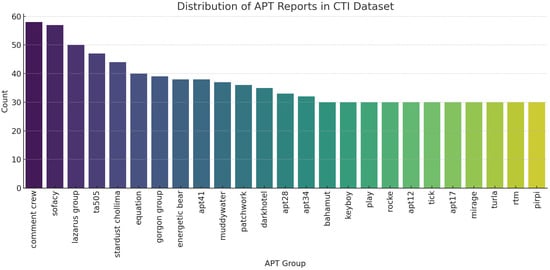
Figure 1.
Distribution of APT classes in the processed CTI dataset. Darker colours indicate higher-frequency groups, whereas lighter colours represent less frequent groups. Class imbalance motivates weighted loss functions and Macro-F1 evaluation.
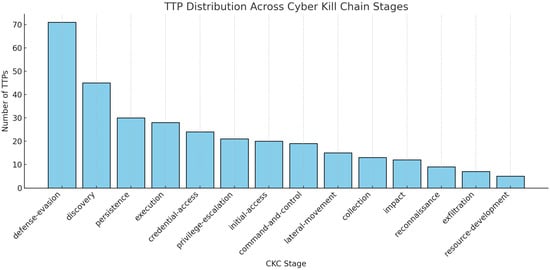
Figure 2.
Distribution of TTPs across Cyber Kill Chain (CKC) stages. Higher counts in defense evasion, discovery, and persistence highlight the procedural skew of the dataset.
A summary of the processed dataset is provided in Table 2.

Table 2.
Dataset summary of the processed APTNotes corpus used in this study.
- TTP–CKC Embeddings.
Each TTP is represented using two complementary components: (1) a 384-dimensional Sentence-BERT (SBERT) embedding capturing semantic meaning, and (2) a one-hot CKC stage vector providing procedural context. The combined TTP feature vector is defined as:
This representation ensures that techniques with similar textual meaning remain close in semantic space while those used in different CKC stages are distinguished procedurally.
- Implementation.
Embeddings were generated using the all-MiniLM-L6-v2 SBERT model (HuggingFace v4.41). Graph preprocessing and tripartite graph construction were implemented in Python 3.10 using PyTorch 2.2 and PyTorch Geometric 2.5, with random seed 42 for reproducibility. Figure 3 visualises the resulting embedding space and the aggregation process used to compute TTP-level and APT-level semantic representations.
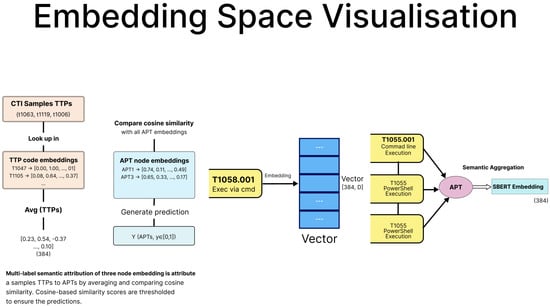
Figure 3.
Semantic embedding process. TTPs are encoded as 384-dimensional SBERT vectors and aggregated. Cosine similarity between TTP and APT embeddings supports semantic attribution and generalisation across related behaviours.
4.2. Graph Construction
The contextualised TTP feature vectors described in Section 4.1 are used to construct a heterogeneous tripartite graph linking APT groups, TTPs, and Cyber Kill Chain (CKC) stages. Each node type captures a distinct aspect of adversary behaviour: actor identity (APT nodes), behavioural technique (TTP nodes), and operational phase (CKC nodes). Relationships among these nodes are encoded using three edge types:
- APT–TTP edges: connect APT groups to the techniques they employ in reported campaigns;
- TTP–CKC edges: link each technique to its corresponding CKC stage, providing lifecycle grounding;
- Temporal TTP–TTP edges: capture the observed order of technique usage within the same campaign, supporting temporal reasoning.
Formally, the heterogeneous graph is defined as:
Here, , , and represent the node sets for APT groups, techniques/ procedures, and CKC stages, respectively. The edge sets encode behavioural relations (), procedural mappings (), and temporal dependencies ().
Figure 4 provides a visual overview of a representative subset of the learned tripartite heterogeneous structure. The complete APT–TTP–CKC graph contains nearly one thousand TTP nodes and thousands of edges, making a full rendering too dense for meaningful inspection. To preserve interpretability, the figure therefore shows only a small, illustrative subset consisting of three representative APT groups together with the TTPs and CKC stages most strongly associated with them in the learned model.
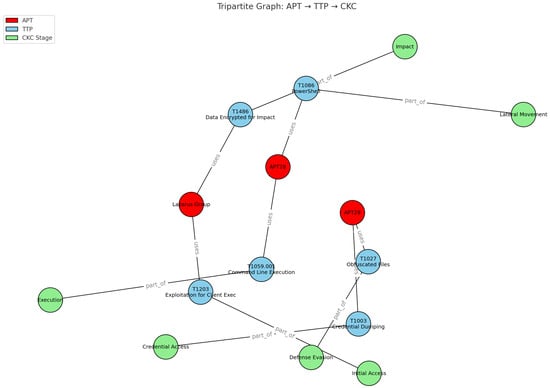
Figure 4.
Tripartite heterogeneous graph linking representative APT (red), TTP (blue), and CKC (green) nodes. Edges encode behavioural (APT–TTP), procedural (TTP–CKC), and temporal (TTP–TTP) relationships. Colours denote node type; line styles denote relation type.
Colours indicate node types (APT = red, TTP = blue, CKC = green), while line styles denote the different relation types (behavioural APT–TTP, procedural TTP–CKC, and temporal TTP–TTP). Some overlapping or intersecting visual elements occur due to graph-layout constraints; however, these do not affect scientific interpretation. The purpose of the figure is to demonstrate the relational structure learned by the model—not to convey exact spatial geometry—and to highlight how different APTs may employ similar techniques or operate within similar CKC stages at different points in their campaigns.
This graph formulation extends prior heterogeneous GNN-based attribution approaches (e.g., APT-MMF []) by explicitly integrating procedural CKC mappings and temporal transitions between techniques. As a result, the model can reason about both what techniques are used and when they occur within the adversarial lifecycle, improving attribution accuracy and interpretability.
4.3. Model Input and Classification
The heterogeneous APT–TTP–CKC graph constructed in Section 4.2 is transformed into node-feature matrices and adjacency structures suitable for GraphSAGE. APT nodes are initialised with SBERT profile embeddings, TTP nodes use the contextualised TTP–CKC vectors defined in Equation (1), and CKC nodes are represented as one-hot stage encodings
GraphSAGE performs neighbourhood aggregation across these relations. For a node of type at layer ℓ, message passing is defined as:
where denotes the relation-specific aggregation function (mean or SAGE-based) and combines neighbour messages with the node’s previous representation. This follows the message-passing formulation introduced by Gilmer et al. [].
Figure 5 illustrates this process, showing how APT, TTP, and CKC nodes exchange information over multiple hops in the heterogeneous graph. The diagram highlights the flow of messages from TTP nodes to APT nodes via both procedural (CKC) and behavioural (TTP) relations, enabling multi-layer reasoning across campaigns.
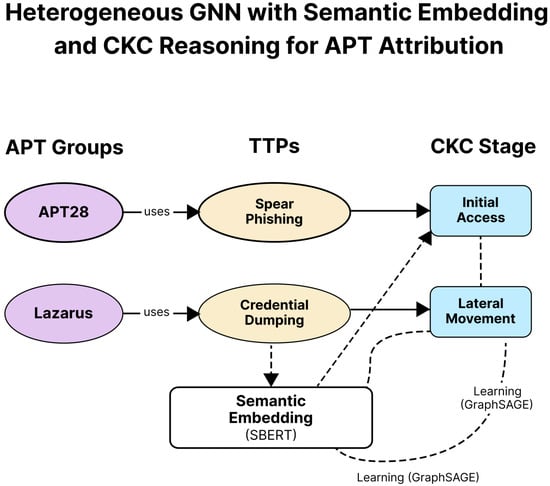
Figure 5.
GraphSAGE-based heterogeneous GNN architecture used for APT attribution. The model aggregates information across APT, TTP, and CKC nodes, enabling multi-hop reasoning over behavioural and procedural relations in the tripartite graph.
APT attribution is formulated as a multi-class classification task. Following [], two embeddings u and v are concatenated with their element-wise difference and passed through a softmax classifier parameterised by :
To address class imbalance, a class-weighted cross-entropy loss [,] is applied:
where weights are inversely proportional to class frequency.
5. Training and Evaluation
The attribution model is trained and evaluated on the heterogeneous APT–TTP–CKC graph introduced in Section 4.2. APT nodes are divided into an 80/20 train–validation split while preserving class distribution. Optimisation uses the Adam optimiser [] with a learning rate of 0.005, weight decay, batch size of 32, and early stopping based on validation Macro-F1.
5.1. Evaluation Metrics
Three standard metrics for imbalanced multi-class classification are reported following prior work [,,]:
where C denotes the number of classes, the per-class F1 score, the support for class c, and N the total number of samples. Together, these metrics balance overall accuracy with robustness to under-represented APT groups.
5.2. Architectural Comparison
Four neural architectures are benchmarked: (1) an LSTM baseline, (2) a GATConv-based heterogeneous GNN, (3) a hybrid GAT + GraphSAGE variant, and (4) the proposed GraphSAGE model.
The results are summarised in Table 3, which presents Macro-F1 and accuracy across architectures. Figure 6 provides a visual comparison of the same metrics.

Table 3.
Comparison of baseline and heterogeneous GNN variants for APT attribution. All models operate on the tripartite APT–TTP–CKC graph; the difference lies in the message-passing operator.
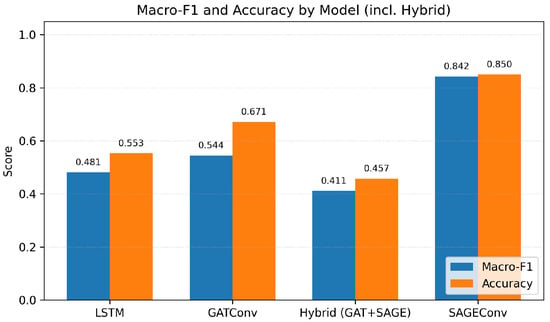
Figure 6.
Macro-F1 and accuracy across all evaluated models. The GraphSAGE architecture achieves the highest performance (Macro-F1 = 0.842, Accuracy = 0.850), demonstrating the benefit of incorporating CKC-stage semantics into TTP embeddings for APT attribution.
6. Performance Analysis
6.1. Overall Performance
The HeteroGNN (GraphSAGE) model consistently outperforms all baselines across both Macro-F1 and Accuracy. As presented in Table 3 and Figure 6, this model achieves the highest overall performance, demonstrating that combining semantic (SBERT) and procedural (CKC) information within the tripartite graph provides stronger representations of APT groups compared with sequence-only (LSTM) or attention-based (HeteroGNN with GATConv) approaches.
In contrast, the Hybrid HeteroGNN (GAT + SAGE) performs the weakest, falling below both individual GNN variants. This indicates that simply combining multiple operators does not necessarily improve results and may introduce additional complexity without clear benefit. Overall, the findings confirm that a heterogeneous GNN with GraphSAGE is the most effective approach for modelling APT attribution in this setting.
6.2. Representation Quality (t-SNE and Class-Wise F1)
To further analyse the quality of the learned representations, we project the APT embeddings into two dimensions using t-SNE and evaluate per-class F1 scores to assess attribution stability across actors. The combination of visual clustering and quantitative class-wise performance provides insight into how well the HeteroGNN model separates behaviourally distinct and overlapping APT groups.
For each APT class c, the F1 score is defined as
following established benchmarking practice [,,]. Well-supported and distinctive APTs (e.g., IDs 8, 14, 18, 21, 24) achieve near-perfect attribution, while under-represented or behaviourally ambiguous groups (e.g., IDs 1, 12, 17) exhibit lower scores. Even so, the distribution is substantially more balanced than that of sequence-only models such as LSTM and prior heterogeneous methods such as APT-MMF.
Figure 7 shows (a) the t-SNE projection of the APT embeddings and (b) the corresponding per-class F1 distribution used to quantify attribution robustness.
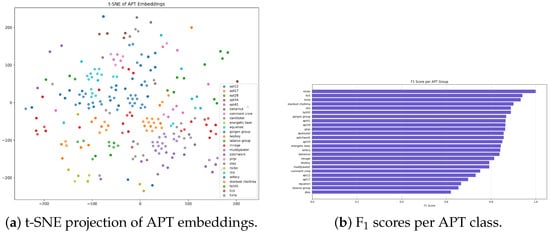
Figure 7.
Representation-quality analysis for the HeteroGNN (GraphSAGE) model. (a) t-SNE visualisation showing well-separated APT clusters. (b) Class-wise F1 distribution highlighting strong attribution for distinctive or well-supported actors.
6.3. Confusion-Matrix Analysis
To further examine prediction behaviour, we analysed the confusion matrix shown in Figure 8. Diagonal dominance indicates strong overall attribution, while misclassifications mainly occur among behaviourally similar groups (e.g., APT12 vs. APT17). This highlights where the model confuses adversaries with overlapping TTP profiles, suggesting potential benefit from incorporating additional temporal or infrastructure-based features.
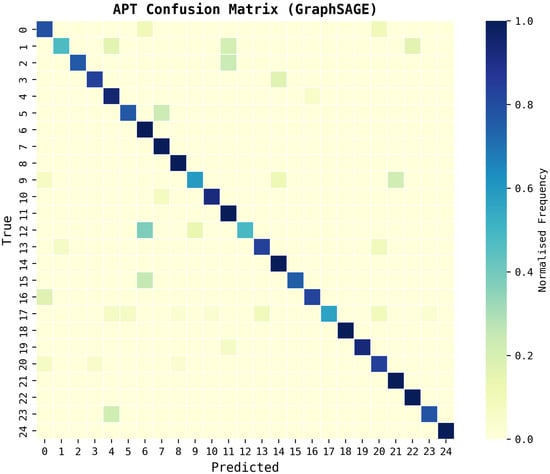
Figure 8.
Confusion matrix for the best-performing model, HeteroGNN (GraphSAGE), showing normalised classification outcomes across all 25 APT groups. Darker diagonal cells indicate correct attributions, while lighter off-diagonal values highlight confusions between behaviourally similar actors (e.g., APT12 and APT17).
6.4. Classification Report
Beyond aggregate metrics such as Accuracy and Macro-F1, Table 4 presents the per-class Precision, Recall, F1-score, and Support for all APT groups in the test set. This detailed breakdown provides a transparent numerical view of model performance and enables reproducible comparison across classes.

Table 4.
Per-class Precision, Recall, F1-score, and Support for each APT group in the test set. Overall Accuracy = 0.85, Macro-F1 = 0.84.
The model achieves strong and balanced performance across most APT groups, with Precision and Recall typically exceeding 0.80 for well-represented actors. Lower scores appear primarily in sparse or behaviourally overlapping groups (e.g., APT12 and APT17), reflecting the inherent difficulty of distinguishing rare adversaries with similar technique profiles. This trend is also noted in prior work such as APT-MMF [], where class imbalance reduces Macro-F1. However, unlike APT-MMF, the incorporation of SBERT semantics and CKC contextualisation helps maintain high Precision even for minority classes, indicating improved robustness under imbalance.
6.5. Learning Dynamics
Validation accuracy per epoch is computed as in Equation (10), and the progression is visualised in Figure 9.
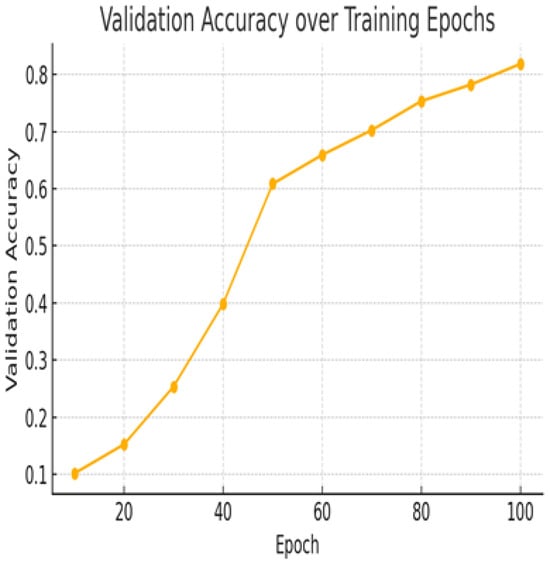
Figure 9.
Validation accuracy across training epochs for GraphSAGE. Rapid early gains followed by stable convergence indicate effective generalisation.
Figure 9 shows that steadily increases from approximately 10% at epoch 10 to above 80% by epoch 100. Steep gains between epochs 30–50 indicate rapid feature consolidation, after which convergence stabilises. The absence of strong oscillations indicates generalisation and no overfitting, aided by the heterogeneous tripartite structure and SBERT embeddings.
6.6. Summary Metrics
Table 5 reports the final summary metrics, confirming that the heterogeneous GNN balances under-represented classes while retaining high accuracy. These results further validate the superiority of the GraphSAGE-based framework over prior APT-attribution approaches such as APT-MMF [] and DeepOP [].

Table 5.
Summary of final model performance.
The complete attribution pipeline—including graph construction, embedding generation, and inference—executes within seconds on an RTX-class GPU (or under one minute on CPU), demonstrating that the proposed framework is computationally efficient and scalable for integration into real-time SOC workflows.
7. Benchmarking Against Prior Work
We benchmark the proposed model against four representative attribution approaches: APT-MMF, DeepOP, CSKG4APT, and GRAIN. These baselines reflect diverse methodological directions, including heterogeneous GNNs, sequence modelling, CTI text analysis, and IoC–TTP graph reasoning. Results are summarised in Table 6, with confusion-matrix behaviour illustrated in Figure 8.

Table 6.
Comparison with related attribution models. Metrics are reproduced from prior work. DeepOP reports technique-sequence F1, whereas this study evaluates actor-level attribution on contextualised CTI (APTNotes).
APT-MMF. Xiao et al. [] introduce a heterogeneous GNN using metapaths and multilevel fusion, achieving a reported Macro-F1 of 0.687. Although effective on frequent TTPs, the approach struggles with long-tail classes due to limited lifecycle modelling. By explicitly incorporating CKC stages and temporal transitions, our model improves balance across rare classes and achieves substantially higher performance (Macro-F1 = 0.842; Table 6).
DeepOP. Zhang et al. [] propose a sequential model that predicts technique progressions, reporting F1 = 0.894 at the technique level. However, DeepOP does not model actor-level context, causing sequence-only reasoning to conflate behaviourally similar actors (e.g., APT12 vs. APT17), as shown in Figure 8. Our model mitigates this limitation by combining SBERT semantics with CKC-aware embeddings, yielding clearer actor separation.
CSKG4APT. Ren et al. [] leverage BERT-based text modelling, achieving F1 ≈ 0.739 on CTI relation extraction. While effective for sentence-level interpretation, the method does not support end-to-end actor attribution and generalises poorly to unseen behaviours. In contrast, our graph-based formulation integrates semantic and lifecycle context directly into model decision-making, improving robustness (Table 6).
GRAIN. Xiao et al. [] explore heterogeneous GNNs over IoC–TTP graphs, reporting F1 = 0.815 for their best FastText configuration. However, GRAIN lacks CKC integration and temporal dependencies, limiting interpretability and lifecycle grounding. By embedding CKC stages alongside SBERT features, our model achieves higher accuracy and richer behavioural understanding.
Summary. Across all baselines, the proposed GraphSAGE-based heterogeneous model demonstrates state-of-the-art performance, driven by the integration of semantic, temporal, and lifecycle-aware features. It outperforms multimodal, sequential, text-only, and heterogeneous alternatives (Table 6; Figure 8).
8. Future Work and Recommendations
While the proposed framework demonstrates strong attribution performance, several promising research and operational directions remain for further development:
- Few-shot and meta-learning. Future work should explore meta-learning and few-shot adaptation techniques to enable attribution of emerging or under-represented APT groups from limited CTI samples. Such methods are essential for newly observed adversaries and zero-day campaigns where labelled data are scarce.
- Synthetic CTI generation. Generative models such as large language models (LLMs) or generative adversarial networks (GANs) could be used to create realistic synthetic CTI for minority APT classes. This would mitigate the long-tail imbalance present in APTNotes and stabilise training for rare actors.
- Adversarial augmentation. Incorporating adversarial perturbations and semantic rephrasings of TTP descriptions during training could improve robustness against deception and false-flag attacks, where adversaries intentionally modify observable behaviours or reporting language.
- Multi-task learning. Jointly predicting Cyber Kill Chain (CKC) stages alongside APT attribution may capture deeper temporal–procedural interactions and strengthen the alignment between model reasoning and adversary lifecycle behaviours.
- Hybrid architectures. Combining heterogeneous GNNs with sequential models such as LSTMs or Transformers could enhance temporal modelling across multiple CTI reports, enabling richer tracking of multi-report campaign evolution.
- Self-supervised pretraining. Leveraging large unlabelled CTI corpora for contrastive or self-supervised pretraining may improve TTP embedding quality and increase resilience in low-data regimes.
- Explainability and SOC integration. Embedding-based visualisation tools (e.g., UMAP or t-SNE) and confusion-matrix dashboards should be incorporated into SOC workflows. These tools would support analyst interpretation of actor clusters, confidence scores, and cross-campaign attribution behaviour in real time.
- Data Splitting and Temporal Isolation
Although a temporal 80/20 split with campaign-level isolation was conceptually applied to reduce the risk of graph leakage, a more comprehensive validation—training strictly on older campaigns and testing on newer ones—remains future work. Implementing rigorous temporal stratification and campaign-aware subgraph partitioning will help ensure that shared TTP nodes or temporal edges do not unintentionally transfer information across splits, strengthening generalisability and addressing peer-review concerns regarding leakage.
- Explainability Enhancement
Future iterations will integrate explanation frameworks such as GNNExplainer and attention-based path tracing to identify and visualise the top-k TTP–CKC paths influencing an attribution decision. These methods will provide interpretable, case-level insights to assist SOC analysts, particularly in scenarios involving deception, ambiguous reporting, or similar adversary behaviours.
- Model Card and Failure Analysis
Future work will include the publication of a detailed model card documenting dataset composition, training configuration, limitations, and failure modes. Special focus will be placed on misclassifications arising from deceptive reporting or false-flag operations, where adversaries intentionally mimic another group’s behavioural profile. Such documentation supports transparency, responsible model deployment, and alignment with emerging best practices for AI-driven cyber threat intelligence systems.
Collectively, these directions aim to advance the proposed attribution framework toward full operational readiness. By improving adaptability, robustness, and interpretability, future extensions will enhance the ability of cyber defence centres to integrate automated graph-based intelligence with analyst-led contextual reasoning in live incident-response environments.
9. Conclusions
This paper presented a heterogeneous graph neural network framework for APT attribution that fuses semantic embeddings, Cyber Kill Chain (CKC) procedural context, and multi-relational message passing. The proposed tripartite design achieves state-of-the-art accuracy and interpretability, demonstrating its potential for operational deployment in SOC environments. While strong empirical results were achieved, residual risks of temporal or campaign-level graph leakage remain an area for refinement and will be addressed through time-aware retraining and campaign-stratified evaluation in future work.
Empirical evaluation (Section 5.2) demonstrated superior attribution performance with 85% accuracy and a Macro-F1 of 0.84, outperforming baselines such as APT-MMF and DeepOP. The confusion matrix and class-wise analysis confirmed robustness against long-tail imbalance, while benchmarking (Section 7) highlighted competitive advantages over infrastructure- or rule-based attribution models. These findings validate the novelty claims made in Section 3: that fusing semantic, procedural, and structural intelligence yields more accurate and interpretable attribution.
Critically, this work also exposes ongoing limitations. While the automated CTI→graph pipeline (Section 4) supports reproducibility and near real-time workflows, challenges remain around rare-class generalisation, deception resistance, and SOC-level explainability. Addressing these issues requires integrating the future research directions discussed in Section 8, especially few-shot learning, hybrid architectures, and interpretable dashboards.
In conclusion, this study not only advances state-of-the-art attribution accuracy but also lays the groundwork for operationally relevant, explainable, and scalable attribution systems. By bridging unstructured CTI with structured graph-based learning, it provides both technical innovation and a clear path toward deployment in real-world cyber defence environments.
Author Contributions
Conceptualization, A.J.M. and A.A.; methodology, A.J.M. and A.A.; software, A.J.M.; validation, A.J.M. and A.A.; formal analysis, A.J.M.; investigation, A.J.M.; resources, A.A.; data curation, A.J.M.; writing—original draft preparation, A.J.M.; writing—review and editing, A.A.; visualization, A.J.M.; supervision, A.A.; project administration, A.A.; funding acquisition, A.A. All authors have read and agreed to the published version of the manuscript.
Funding
This research received no external funding.
Data Availability Statement
The processed graph artefacts (node/edge indices and configuration files) and the training/evaluation scripts are available from the corresponding author on reasonable request for research purposes. Raw CTI sources originate from the APTNotes corpus (publicly available); any redistribution will respect the original licenses.
Conflicts of Interest
The authors declare no conflict of interest.
References
- Irshad, E.; Siddiqui, A.B. Cyber threat attribution using unstructured reports in cyber threat intelligence. Egypt. Inform. J. 2023, 24, 43–59. [Google Scholar] [CrossRef]
- Xiao, N.; Lang, B.; Wang, T.; Chen, Y. APT-MMF: An advanced persistent threat actor attribution method based on multimodal and multilevel feature fusion. Comput. Secur. 2024, 144, 103960. [Google Scholar] [CrossRef]
- Ren, Y.; Xiao, Y.; Zhou, Y.; Zhang, Z.; Tian, Z. CSKG4APT: A cybersecurity knowledge graph for advanced persistent threat organization attribution. IEEE Trans. Knowl. Data Eng. 2023, 35, 5695–5709. [Google Scholar] [CrossRef]
- Hwang, S.; Kim, T.S. An exploratory study on artifacts for cyber attack attribution considering false flag: Using Delphi and AHP methods. IEEE Access 2023, 11, 74533–74544. [Google Scholar] [CrossRef]
- Goel, S.; Nussbaum, B. Attribution across cyber attack types: Network intrusions and information operations. IEEE Open J. Commun. Soc. 2021, 2, 942–953. [Google Scholar] [CrossRef]
- Xiang, X.; Liu, H.; Zeng, L.; Zhang, H.; Gu, Z. IPAttributor: Cyber attacker attribution with threat intelligence-enriched intrusion data. Mathematics 2024, 12, 1364. [Google Scholar] [CrossRef]
- Zhang, S.; Xue, X.; Su, X. DeepOP: A hybrid framework for MITRE ATT&CK sequence prediction via deep learning and ontology. Electronics 2025, 14, 257. [Google Scholar] [CrossRef]
- Rosenberg, I.; Sicard, G.; David, E. DeepAPT: Nation-state APT attribution using end-to-end deep neural networks. In Proceedings of the Artificial Neural Networks and Machine Learning—ICANN 2017; Lecture Notes in Computer Science; Springer: Cham, Switzerland, 2017; Volume 10614, pp. 91–99. [Google Scholar] [CrossRef]
- Hutchins, E.M.; Cloppert, M.J.; Amin, R.M. Intelligence-Driven Computer Network Defense Informed by Analysis of Adversary Campaigns and Intrusion Kill Chains; Technical Report LM White Paper; Lockheed Martin: San Jose, CA, USA, 2011. [Google Scholar]
- Reimers, N.; Gurevych, I. Sentence-BERT: Sentence Embeddings using Siamese BERT-Networks. In Proceedings of the 2019 Conference on Empirical Methods in Natural Language Processing and the 9th International Joint Conference on Natural Language Processing (EMNLP-IJCNLP), Hong Kong, China, 3–7 November 2019; Association for Computational Linguistics: Stroudsburg, PA, USA, 2019; pp. 3982–3992. [Google Scholar] [CrossRef]
- Xiao, F.; Chen, S.; Yang, J.; He, H.; Jiang, X.; Tan, X.; Jin, D. GRAIN: Graph neural network and reinforcement learning aided causality discovery for multi-step attack scenario reconstruction. Comput. Secur. 2025, 148, 104180. [Google Scholar] [CrossRef]
- Yan, N.; Zhu, H.; Zhang, J.; Peng, T.; Zhang, X.; Zhang, H.; Huang, T.; Lin, X.; Liu, S.; Liu, X. Deepro: Provenance-based APT campaigns detection via GNN. In Proceedings of the IEEE IInternational Conference on Trust, Security and Privacy in Computing and Communications (TrustCom), Wuhan, China, 9–11 December 2022; pp. 747–758. [Google Scholar] [CrossRef]
- Gilmer, J.; Schoenholz, S.S.; Riley, P.F.; Vinyals, O.; Dahl, G.E. Neural Message Passing for Quantum Chemistry. In Proceedings of the 34th International Conference on Machine Learning (ICML), Sydney, Australia, 6–11 August 2017; Volume 70, pp. 1263–1272. [Google Scholar]
- He, H.; Garcia, E.A. Learning from imbalanced data. IEEE Trans. Knowl. Data Eng. 2009, 21, 1263–1284. [Google Scholar] [CrossRef]
- Cui, Y.; Jia, M.; Lin, T.Y.; Song, Y.; Belongie, S. Class-Balanced Loss Based on Effective Number of Samples. In Proceedings of the CVPR, Long Beach, CA, USA, 15–20 June 2019. [Google Scholar]
- Kingma, D.P.; Ba, J. Adam: A Method for Stochastic Optimization. arXiv 2014, arXiv:1412.6980. [Google Scholar] [CrossRef]
Disclaimer/Publisher’s Note: The statements, opinions and data contained in all publications are solely those of the individual author(s) and contributor(s) and not of MDPI and/or the editor(s). MDPI and/or the editor(s) disclaim responsibility for any injury to people or property resulting from any ideas, methods, instructions or products referred to in the content. |
© 2025 by the authors. Licensee MDPI, Basel, Switzerland. This article is an open access article distributed under the terms and conditions of the Creative Commons Attribution (CC BY) license (https://creativecommons.org/licenses/by/4.0/).